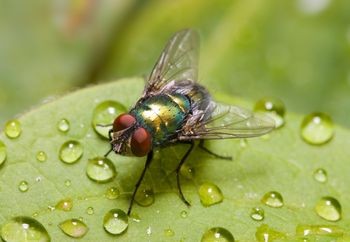Fly Control In Auckland
Need help? Call us now!
NZ Pest Control offers pest control treatments for Auckland home and commercial premises. Contact us for a free quote today.
NZ Pest Control - Your Pest Control Specialists!
What Our Customers Say
Collected through Google My Business


What is a Fly?
Flies are insects of the order ‘Diptera’ and have a single pair of wings. Of the many types of flies, the most common encountered by NZ Pest Control are:
- Blow Fly or Bottle Fly – Adults are about 4-16 mm long, the size of a house fly, or slightly larger. Mature larvae are about 9-22 mm long. They have sponging mouthparts; antennae are feathery, at least on the bottom two thirds. Larvae are eyeless, legless, tapered from large, rounded rear segment to head, which is a pair of dark hooks. Adults are partly or wholly metallic blue, green, or dull brassy, sometimes black. Larvae are pale yellow to white.
- Fruit Flies – Small fruit fly and vinegar fly adults are about 3-4 mm long, including wings. Adult small fruit flies have antenna with a feathery bristle; wings with thickened front margins, intersected in two places. Mature larvae are about 7-8 mm long, eyeless, legless and tapered from large rounded rear to the pair of dark mouth hooks at the “head” end. Adults are dull tan to brownish yellow or brownish black; eyes usually bright red. Larvae are nearly white, except mouth hooks which are black and the tips of the abdominal breathing pores which are yellowish.
- House Flies – House fly adult is about 4-7.5 mm long, female larger than male. Mature larva is about 7-10mm. Adult face has 2 velvety strips, silver above and gold below; thorax has 4 narrow stripes; no pale spot behind head or rear tip of thorax; sides of abdomen usually pale; sponging mouth parts. Larva is eyeless, legless, tapered from rear to head, which is a pair of dark hooks. Adult is dull gray. Larva is cream colored and greasy looking.
- Cluster Flies – Adult cluster flies, which are a little larger than common house flies range in size from 9-12.5mm long. They are black with short, yellow hairs on their thorax and wings that overlap while resting. The eggs and larvae of cluster flies are very rarely seen as they are deposited into the soil near earthworm burrows. The larvae then feed on the earthworms. Cluster flies are considered a nuisance pest as they survive the winter by hibernating inside wall voids and attics inside our homes and other buildings. They enter through cracks in the foundation, attic vents, gaps in exterior siding and other small openings in the fall when the temperatures begin to drop. They are primarily dormant over the winter, but may emerge on warm, sunny winter days when some of the flies may become active.
- Drain Fly – Drain flies, also known as moth flies, range from 1.5-5mm long. They are dark or grayish in color and under hand-held magnification drain flies are seen to have a fuzzy, hair-like covered body with large, horizontal wings. Drain flies make poor fliers. They have a short, frenzied flight path and are only able to cover a few feet at best. Drain flies lay their eggs in the moist, organic matter that accumulates inside of drains, in overflow pipes and garbage disposals. The larvae are approximately 9.5mm long, legless and wormlike. Although drain flies do not bite, they may become a nuisance as their populations grow.
Why do I have them?
As with the majority of pests, flies are looking for a source of food and a safe place to breed and live. The type of food preferred depends upon the species of fly, but may include:
- Meat; animal carcasses, especially those of birds and other small animals
- Excrement
- Decaying vegetation
- Garbage
- Fresh fruits and vegetables such as bananas, grapes, peaches, pineapples, tomatoes
- Fermenting liquids, such as beer, cider, vinegar and wine
Are they dangerous?
Yes. Many flies liquefy solid foods by regurgitation, thus contaminating food and spreading disease.
How do I get rid of flies?
Controlling flies in and around your property can be a difficult task and unless all traces of their food source and breeding areas are removed, they can very quickly re-infest. Calling NZ Pest Control is your best bet for a quick, efficient and safe resolution to your fly problem.
Can I do it myself?
While there are some do-it-yourself fly control products on the market, they are generally ineffective unless proper and continued maintenance is carried out. It is worth remembering that if chemicals are used in do-it-yourself pest control, they can be dangerous to humans and pets if mixed or used improperly.
Let us help you
How soon can you get here?
At NZ Pest Control, we strive to give our customers a rapid, efficient service, and make every effort to be with you as soon as possible.
Is the treatment safe?
All products used by NZ Pest Control, must have first been thoroughly checked by the EPA and registered for pest control use. Only then can they be considered for use by our highly trained pest control professionals. You can be assured that pest control services provided by NZ Pest Control will not cause any harm to humans or pets.
How can I prevent flies returning in the future?
Preventing flies can be a very difficult task due to their wide variety of food sources and breeding sites. Should your property become inhabited by flies, your first call should be to NZ Pest Control. We are committed to improving the quality of life for all of our customers, by providing the safest and most effective treatment for the management of pests, which pose a threat to their health, property and food supply.







